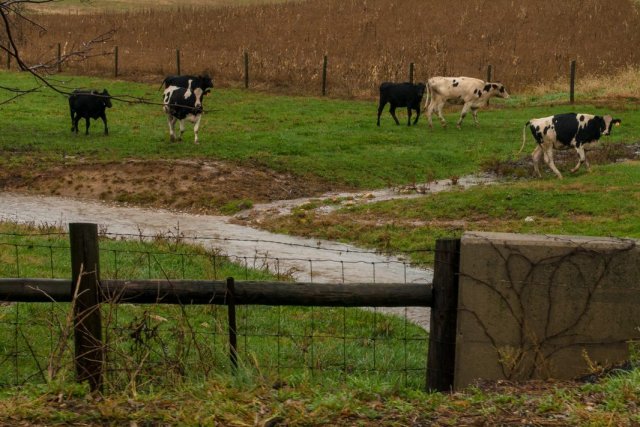Common Considerations

Basic considerations for source water protection include both water quality and water availability. More detailed information on potential sources of contamination within a drinking water utility's delineated source water protection area can be found in a source water assessment.
On this page:
Water Quality
The quality of source water used by a drinking water treatment plant has a direct impact on its operations. It can be impacted by the local geology, topography, land use, and activities within and outside the watershed or wellhead capture zone.
Types of Pollution
Water pollution is often described as originating from a "point" or "nonpoint" source. Point source pollution can be traced to a specific location, like a pipe that is releasing treated wastewater to a river. Nonpoint source pollution generally is described as pollution from large, nonspecific sources - for example, land runoff, rain, snow, atmospheric deposition, drainage, seepage or hydrologic modification. Common types of nonpoint source pollution are runoff of fertilizer and pesticides from agricultural land or residential areas, and sediment from eroding streambanks.
States report that nonpoint source pollution is the leading remaining cause of water quality problems. The effects of nonpoint source pollutants on specific waters vary and may not always be fully understood assessed. However, these pollutants have harmful effects on drinking water supplies, recreation, fisheries and wildlife.
Learn more about pollution management of point and nonpoint sources, such as:
- EPA's National Pollutant Discharge Elimination System (NPDES) permit program addresses water pollution by regulating point sources that discharge pollutants to waters of the United States.
- EPA's Nonpoint Source Pollution program - Nonpoint source pollution is not regulated like point source pollution. Control of nonpoint source pollution is implemented through a variety of best management practices, many of which are voluntary.
Contaminants That Can Affect Drinking Water
The following contaminants can affect drinking water treatment plant operations or human health. While all contaminants can pose a challenge to drinking water utilities, the following contaminants present common and complex challenges.
Nutrients
Nitrate is a necessary nutrient for plant and animal growth. However, elevated levels of nitrate and other nutrients may lead to harmful algal blooms and other ecological degradation. High levels of nitrate are also harmful to human health. EPA has a national primary drinking water regulation for nitrate with a maximum contamination level (MCL) of 10 mg/L (as nitrate-N) for most public water systems. Sources of elevated nitrate in surface and groundwaters include fertilizer runoff, leaking septic tanks, damaged sewage lines, cross-connections, industrial discharges, and atmospheric deposition. Drinking water treatment for high levels of nitrate in source water can be complex and costly. In source waters where harmful algal blooms are present, drinking water utilities may also consider monitoring and treating for cyano-toxins.
Pathogens
Pathogens are microorganisms that can cause illness. Pathogens in surface and groundwaters may come from animal waste (including from wildlife, livestock, and pets), malfunctioning or poorly sited septic tanks, damaged sewage lines or cross-connections, and combined sewage overflow events.
Salt
Dramatic increases in salt (sodium chloride) concentrations are occurring in freshwaters globally due to human activities such as road salt application, water softening, mining and oil extraction, wastewater from commercial and industrial processes, weathering of concrete, sea level rise, and fertilizer application. Too much salt in the environment is toxic and lethal to aquatic life, pollutes drinking water sources, and damages infrastructure.
Suspended Sediment/Turbidity
Suspended sediment and turbidity are measures of water clarity or how many solids are in the water. High turbidity can also be an indicator of high total organic carbon (TOC). This material must be settled out or filtered during the drinking water treatment process. High turbidity events can overwhelm a treatment plant's capacity to filter the water and result in the treatment plant choosing to temporarily shut-off an intake in order to protect their operations. Additionally, TOC can react with certain disinfection chemicals and cause harmful disinfection by-products.
Contaminants of Emerging Concern
Contaminants of emerging concern (CECs), including pharmaceuticals and personal care products (PPCPs), per- and poly-fluoroalkyl substance (PFAS), and cyanotoxins may be found in surface water or groundwater. Many of these contaminants are not regulated by the Safe Drinking Water Act. However, they are considered when developing the Contaminant Candidate List (CCL), a list of unregulated contaminants known or anticipated to occur in public water systems. CECs have a variety of sources including industrial discharge, wastewater discharge, runoff, and atmospheric deposition and EPA continues to work to understand the potential health impacts.
Water Availability
Water availability is also vital for the reliable delivery of safe drinking water. Droughts, floods, over pumping of aquifers, river diversions, or other management practices can affect the availability of drinking water sources. Changes in water availability can also impact water quality.
Resources for Assessing and Addressing Water Availability
For Utilities
- Resiliency Planning
- Natural Hazard Mitigation & Response (floods, earthquakes, and drought)
Water Availability Data
